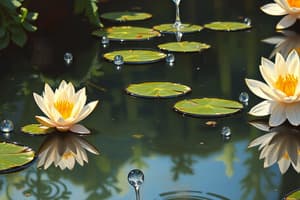Podcast
Questions and Answers
Water molecules are polar, with the:
Water molecules are polar, with the:
- Oxygen side being slightly negative and the hydrogen side being slightly positive (correct)
- Oxygen and hydrogen sides being slightly negative
- Oxygen side being slightly positive and the hydrogen side being slightly negative
- Oxygen and hydrogen sides being slightly positive
If an atom contains 3 protons, 4 neutrons, and 3 electrons, its mass number would be:
If an atom contains 3 protons, 4 neutrons, and 3 electrons, its mass number would be:
- 11
- 3
- 7 (correct)
- 4
A solution is a(n)...
A solution is a(n)...
- Combination of 2 or more liquids
- Combination of isotopes
- Chemical reaction
- Evenly distributed mixture of 2 or more substances (correct)
Enzymes affect the reactions in living cells by changing the...
Enzymes affect the reactions in living cells by changing the...
Acidic solutions have a pH that is:
Acidic solutions have a pH that is:
The 3 particles that make up atoms are:
The 3 particles that make up atoms are:
What type of electron is available to form bonds?
What type of electron is available to form bonds?
If the pH of stomach acid and of oven cleaner were measured:
If the pH of stomach acid and of oven cleaner were measured:
A substance with a pH of 6 is called:
A substance with a pH of 6 is called:
If an atom contains 11 protons and 12 neutrons, its atomic number is:
If an atom contains 11 protons and 12 neutrons, its atomic number is:
Which of the following states of matter contain(s) particles that are tightly linked together in a definite shape?
Which of the following states of matter contain(s) particles that are tightly linked together in a definite shape?
Which of the following terms describes a substance formed by the combination of 2 or more elements in definite proportions?
Which of the following terms describes a substance formed by the combination of 2 or more elements in definite proportions?
A covalent bond is formed as the result of:
A covalent bond is formed as the result of:
In a water molecule, shared electrons spend more time around the oxygen atom than the hydrogen atoms. As a result, the oxygen atom is:
In a water molecule, shared electrons spend more time around the oxygen atom than the hydrogen atoms. As a result, the oxygen atom is:
A neutral solution has an equal number of:
A neutral solution has an equal number of:
Isotopes are atoms of the same element with the same number of protons and:
Isotopes are atoms of the same element with the same number of protons and:
All matter in the universe is composed of:
All matter in the universe is composed of:
The concentration of a solution is:
The concentration of a solution is:
Flashcards are hidden until you start studying
Study Notes
Water Molecules and Polarity
- Water molecules are polar; oxygen side is slightly negative while hydrogen side is slightly positive.
Atomic Structure
- An atom with 3 protons, 4 neutrons, and 3 electrons has a mass number of 7.
- The three particles that make up atoms are protons, neutrons, and electrons.
- An atom with 11 protons and 12 neutrons has an atomic number of 11.
Solutions and Mixtures
- A solution is an evenly distributed mixture of two or more substances.
- The concentration of a solution refers to the amount of solute dissolved in a fixed amount of solution.
Enzymes and Reactions
- Enzymes influence chemical reactions by changing the speed of the reaction.
Acidity and pH
- Acidic solutions have a pH less than 7; a substance with a pH of 6 is classified as an acid.
- Stomach acid has a pH below 7, while oven cleaner has a pH above 7.
Bonds and Electrons
- Valence electrons are available to form bonds through sharing (covalent bonds) rather than transferring (ionic bonds).
- A covalent bond results from sharing an electron pair.
States of Matter
- Solids are states of matter where particles are tightly linked together, maintaining a definite shape.
Compounds and Isotopes
- Compounds are formed by the combination of two or more elements in definite proportions.
- Isotopes are atoms of the same element that have the same number of protons but differ in the number of neutrons.
Neutral Solutions
- A neutral solution contains an equal number of hydroxide and hydronium ions, balancing the pH.
Fundamental Composition of Matter
- All matter in the universe is composed of atoms, which are the basic building blocks.
Studying That Suits You
Use AI to generate personalized quizzes and flashcards to suit your learning preferences.





